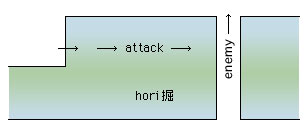|
||
 |
||
1@Attacking from the side. Also sokusha ¤Ë, sokubou ¤h. An arrow, gun or a cannon attack on one side of enemy lines, to prevent the enemy scaling a castle entrance or embankment. Usually a specially built structure or bends in the castle ramparts are used for this purpose, see 2 below. These side attacks are called *jun'yokoya ¡î when launched from the left side of the castle entrance, and gyakuyokoya t¡î when attacking from the right of the entrance, as viewed from outside the castle .
2@Any castle structure built to attack the enemy from the side, see 1 above. This included bent, curved or indented embankments, ramparts and moats, and special compounds and towers for side attacks. Medieval mountain castles often had yokoya towers separate from the main castle, whilst castles built by later members of the Houjou kð clan had bends built into dry moats *karabori óx for this purpose. Medieval yokoya were usually curved in shape maruyokoya Û¡î, but in the Edo period stone-faced ramparts *ishigaki Î_ meant that castle structures could contain sharp bends. Yokoya with right-angled or acute-angled bends were developed, gradually increasing in complexity. Examples include the folding screen type yokoya byoubuori ¡î Ü, dropped-off corner type *yokoya sumiotoshi ¡îp, and the square type *yokoya masugata ¡î`.
@
(C)2001 Japanese Architecture and Art Net Users System.@No reproduction or republication without written permission.
fÚÌeLXgEÊ^ECXgÈÇASÄÌRec̳f¡»E]ÚðֶܷB


